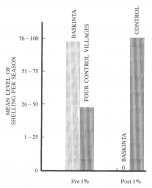Study 7: Prospective 1% effect study in Lebanon
In order to test the kind of effect achieved through the 1% TM effect in a real war situation, a village with around 10.000 inhabitants was selected in Lebanon at the time of the civil war (1980), and it was declared up front that violence would decrease in this village, compared to other villages in the same region with the same demographic variables. Transcendental Meditation teachers started teaching the TM technique to locals in the village, without explaining the actual purpose of the study. They only spoke of personal advantages of the technique. As soon as the 1% threshold was reached, in the summer of 1982, people looked at the number of “shells” fired (grenades and mortars), the number of deaths and the number of injured over a period of 2 years. As the source for their data they took the largest, most objective newspaper in Lebanon.

Spring had always been the time of year where most fights occurred. Prior to reaching 1%, 45 mortars were fired in the village in the spring of 1979, 50 in 1980, 1705 in 1981 and 353 in 1982. In the spring of 1983, when 1% of the village had learned TM, not a single mortar or grenade was fired (p<.00001). During the subsequent 2 years not a single death occurred in the village (Baskinta) (p<.005), not a single injury (p<.005), and not a single case of damage to housing (p<.005) as a result of war violence. In the 4 control cities, less than 20 km away from this village, violence increased in the 2 years after the summer of 1982, in comparison to the previous 4 years.Ref.Scientific Research on Maharishi’s Transcendental Meditation, Collected Papers vol. 4, No. 331 pp. 2623-2633
Hur kan en så enkel teknik göra så mycket?
Över 600 vetenskapliga studier bekräftar TM:s effekter på:
- Utveckling av hjärnan
- Hur TM fungerar
- ADHD
- Intelligens
- Kreativitet

